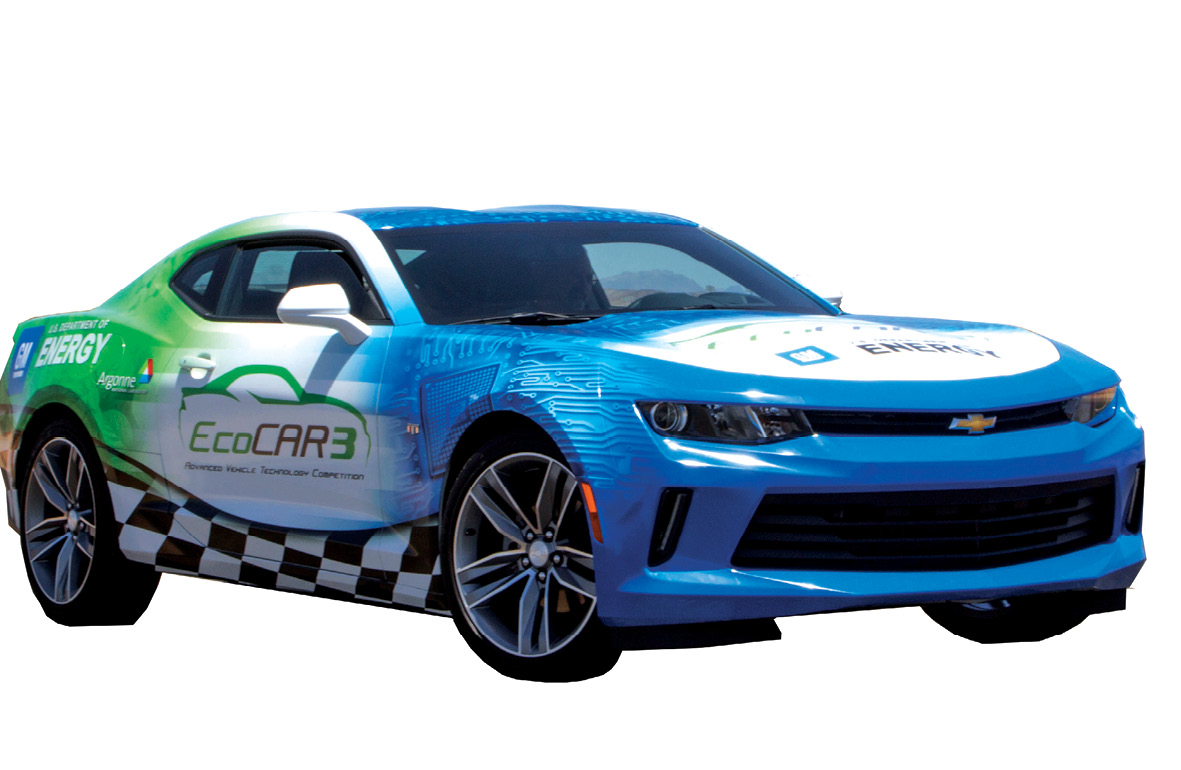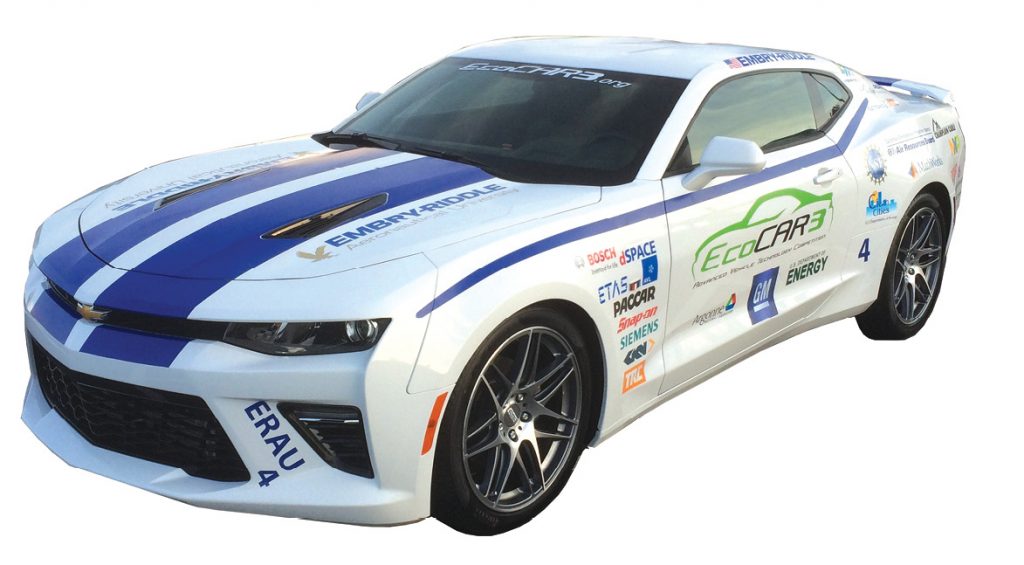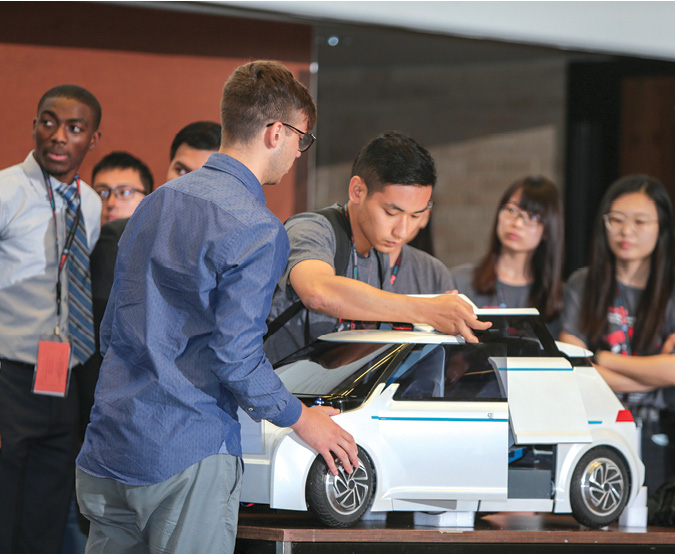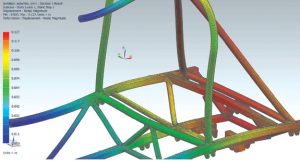
OSU’s EcoCAR team gets a crash course in real-world engineering disciplines, including advanced testing. Image Courtesy of The Ohio State University.
Latest News
March 1, 2017
Andrew Huster, a second year electrical engineering graduate student, can’t wait to step into his first professional gig at General Motors working on active safety features and integration. Yet before coming on board this August, The Ohio State University (OSU) student has already begun building out an impressive resume that includes internships at dSPACE, Ford and GM, along with carefully honed skills in hardware-in-the-loop testing and other advanced competencies.
 OSU’s EcoCAR team gets a crash course in real-world engineering disciplines, including advanced testing. Image Courtesy of The Ohio State University.
OSU’s EcoCAR team gets a crash course in real-world engineering disciplines, including advanced testing. Image Courtesy of The Ohio State University.How was Huster able to amass such marketable skills and hands-on experience while still knee deep in his studies? He spent five years on the OSU team competing in the EcoCAR challenge. Participation in the student competition helped fortify his technical acumen while building invaluable leadership, project management and collaboration skills that Huster contends is just not possible through traditional classroom learning.
“The engineering curriculum was a lot of theory and not a lot of practice or application,” he says. “EcoCAR taught me a lot of technical skills and how to apply them along with how to work with and manage groups of people. I don’t think I would have gotten this far without that experience.”
Huster and many other university-level students are getting a significant jumpstart on their careers through participation in student competitions like EcoCAR, Formula SAE and the Solar Car Challenge. Beyond the automotive space, there are competitions targeting a range of industries, including civil engineering (the AISC Steel Bridge Competition, for example), robotics, and even next-generation transportation like Space X’s Hyperloop Competition. While typically not a formal part of most university-level engineering programs, extracurricular student competitions are increasingly playing an important role in preparing up and coming engineers to apply what they’ve learned to better handle the complexities and unknowns of real-world design problems.
“If you put students in a classroom and throw equations at them all day, they don’t necessarily understand,” says Patrick Currier Ph.D., an associate professor in the Mechanical Engineering department at Embry-Riddle Aeronautical University and the lead adviser for the school’s EcoCAR team. “If you give them an opportunity to participate in one of these student competitions, they get a chance to apply what they’ve learned, see how it works, and it creates a feedback loop—the classroom gets easier and the competition gets easier and they feed off each other.”
 The EcoCAR competition gives engineering students at Embry-Riddle Aeronautical University a chance to apply multidisciplinary design principles. Image Courtesy of Embry-Riddle.
The EcoCAR competition gives engineering students at Embry-Riddle Aeronautical University a chance to apply multidisciplinary design principles. Image Courtesy of Embry-Riddle.A lot of what the students learn is practical stuff that isn’t born out through the traditional course curriculum, Currier says. For example, students need to learn that just because something can be drawn in CAD doesn’t mean it can be produced cost effectively. Similarly, just because there is an opportunity to spend three weeks optimizing a part doesn’t mean that’s the most efficient use of time or the best possible design strategy. “It’s the kind of stuff you don’t really get through the classroom unless you have a chance to work on one of these projects,” he explains.
Thinking Outside the Lecture Hall
Given that most university-level engineering curriculums are dense and tightly scripted to cover maximum ground, there is limited time for students to explore specialty areas or immerse themselves in experiential learning, notes Shawn Midlam Mohler, associate professor of Practice, Mechanical & Aerospace Engineering at OSU. Student competitions, on the other hand, provide an outlet for students to put what they learned in class to practice while engaging in more free-range thinking and creative problem solving, he says.
In addition to sparking outside-the-box problem solving, competitions also give students an opportunity to develop soft, non-technical skills that are essential to success in the workplace. Working on a project like EcoCAR, for example, exposes students to situations that require communications skills and show them how to collaborate effectively with other team members. Student participants are also forced to roll up their sleeves and get immersed in standard business practices in areas such as balancing budgets, project management, meeting deadlines, and of course, Midlam Mohler says, competing in high-stakes competitions.
“These students are running vehicle programs like a small business with responsibility for several hundred thousand dollars to cover parts, testing, even machining services,” he explains. “Students are functioning in an environment where they lead teams and have decision-making authority—that makes them mature so quickly.”
 A team of international students present their Reconfigurable Shared-Use Mobility System in a future mobility competition at the PACE Annual Forum. Image Courtesy of Siemens PLM Software.
A team of international students present their Reconfigurable Shared-Use Mobility System in a future mobility competition at the PACE Annual Forum. Image Courtesy of Siemens PLM Software.Practicing creativity and learning how to function effectively as a member of a team are the two areas where Harvey Bell sees the greatest impact. Bell, a 39-year veteran of GM, is now professor of Engineering Practice and the co-director of the Multidisciplinary Design Program at University of Michigan’s College of Engineering. One of his primary objectives is to integrate more hands-on style applied learning into the university’s curriculum.
Unlike classroom learning and projects where students function mainly as “sole proprietors,” student teams thrust them into situations where they have to be creative and figure out how to operate as a well-oiled machine, Bell says. “No one gets fired because they can’t crank out a spreadsheet or do analysis—they get fired because they flunk Sandbox 101 and don’t play well with others,” he explains. “On competitions, students have to learn how to intellectually disagree with each other and still remain friends and be respectful.”
As part of UofM’s Multidisciplinary Design Program, Bell says that students are encouraged to participate in any number of student competitions for which they can receive course credit. At OSU, students are encouraged to participate in these competitions as an extracurricular activity for their freshman and sophomore years, but if they stick with it beyond that, there are ways to integrate it into their senior capstone design project and receive course credit, adds Midlam Mohler.
Hands-on Learning
Along with university professors, the leading design tool vendors are also playing a key role in promoting and supporting student competitions. In addition to providing student teams competing in challenges with training and its modeFRONTIER optimization software, ESTECO Academy is partnering with Aprilia Racing to expose students to multidisciplinary tools and practices, notes Enrico Nobile, a co-founder of ESTECO, a professor of mechanical engineering at the University of Trieste, and the scientific adviser for the team. As part of the competition, students design a four-stroke single cylinder engine for a motorcycle using multidisciplinary optimization—a discipline that isn’t readily covered in most engineering curriculum, Nobile says.
“The design competitions help students think outside the box and learn how to apply a true multidisciplinary approach unlike standard coursework, which considers them mostly separate,” he explains.
Siemens PLM Software also takes an active role in supporting a range of student teams, including EcoCAR, PACE, Greenpower, Formula Student, and more recently, the Hyperloop competition along with FIRST Robotics and a number of other programs aimed at the K-12 level. The PLM provider delivers software, training and sometimes financial backing for the teams, according to Dora Smith, Siemens’ global director of its academic program. She says competitions are an instrumental component of preparing students for real-world engineering challenges.
 University of Maryland students participating in SpaceX’s Hyperloop competition are leveraging Siemens simulation software to model their dynamic test rig. Image Courtesy of University of Maryland.
University of Maryland students participating in SpaceX’s Hyperloop competition are leveraging Siemens simulation software to model their dynamic test rig. Image Courtesy of University of Maryland.One example is early exposure to the tools used on the job, which can deliver a leg up, Smith says. “When you have a single course, you might be introduced to CAD or simulation, but you’re not applying it in an actual project,” she explains. “This is about bringing it all together.”
MathWorks has been involved the Advanced Vehicle Technology Competitions (ATVC) series, sponsored by the Department of Energy, for more than 15 years, according to Paul Smith, director of consulting services, MathWorks. Its sponsorship has changed from software donations and small contributions to mentoring and training for the student teams. “We provide software to the main part of the competition for simulation,” he says. “In large part, what these students are doing with our tools is what automotive engineers are doing with our tools at the leading companies worldwide. Student competitions like EcoCAR helps create a strong talent pool to draw from.”
Student participants in competitions typically have an advantage over fellow students when it comes time to compete for an internship or even that first job. For example, the typical mechanical engineering student might get a fluid dynamics lesson in how to determine the flow of fluid through pipes. In comparison, a student who has worked on a competition team understands how to apply that knowledge to generate the best result. “We might teach how to calculate how fast fluid flows through a pipe and what size pipe to use, but without reducing it to practice, they have no idea how to make fluid connections,” Midlam Mohler says. “Recruiters can tell within two or three minutes of talking with a student whether they have experience like this.”
Christina Kuwabara, a junior at OSU majoring in mechanical engineering and a member of the EcoCAR team, says the experience gave her exposure to processes and tools (MathWorks’ MATLAB and Simulink, in particular) that she wouldn’t get in day-to-day classroom learning. This in turn landed her a multi-year internship at Honda where she’s working on controls, system modeling, simulation and testing. “During the interview, they asked me questions about EcoCAR—what test procedures I worked on, how we validated our results—not about what I learned in class,” she says. “It was like I already had a job and we were talking about experience.”
Same deal for Huster, who says his five years with the EcoCAR team and his ability to learn advanced skills like hardware-in-the-loop testing set him apart from his student peers and made the multi-hours a week time commitment well worth it.
“Participating in these competitions isn’t necessary per se, but it’s definitely a really good way to put yourself above the rest of your class when you start applying for jobs and you want to stand out,” Huster says. “My advice is to get involved—it’s well worth the extra time and effort.”
More Info
Subscribe to our FREE magazine, FREE email newsletters or both!
Latest News
About the Author
Beth Stackpole is a contributing editor to Digital Engineering. Send e-mail about this article to [email protected].
Follow DE





